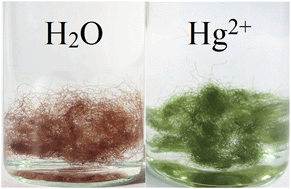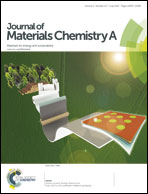A highly selective and sensitive recyclable colorimetric Hg2+ sensor based on the porphyrin-functionalized polyacrylonitrile fiber†
Abstract
A colorimetric Hg2+ sensor based on the porphyrin-functionalized polyacrylonitrile fiber (CTAPP–PANAF) was prepared and investigated. This functional fiber sensor shows excellent selectivity and sensitivity towards Hg2+ over other common metal ions (Pb2+, Ba2+, Cd2+, Ag+, Zn2+, Cu2+, Ni2+, Co2+, Fe3+, Mn2+, Cr3+, Ca2+, Al3+ and Mg2+). Upon the addition of Hg2+, a remarkable visual color change from red-brown to dark-green and significant detectable changes in the FTIR, UV and FL spectra of CTAPP–PANAF were observed. The naked-eye detection limit is as low as 20 ppb (1 × 10−7 mol L−1), which is below the maximum contamination level of 50 ppb for mercury containing wastewater in China. This functional fiber sensor also exhibits excellent reusability and recyclability and can be repeatedly used more than 50 times. The Hg2+ complexed sensor can be easily separated from the aqueous solution by simple filtration and reversed back by treating with dilute HCl. Furthermore, real water sample testing confirms the practical application of CTAPP–PANAF. In a word, the fiber sensor possesses the advantages of simplicity, rapidity, and reusability as well as high selectivity and sensitivity.


 Please wait while we load your content...
Please wait while we load your content...